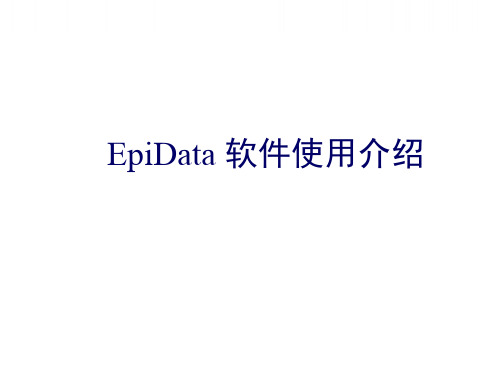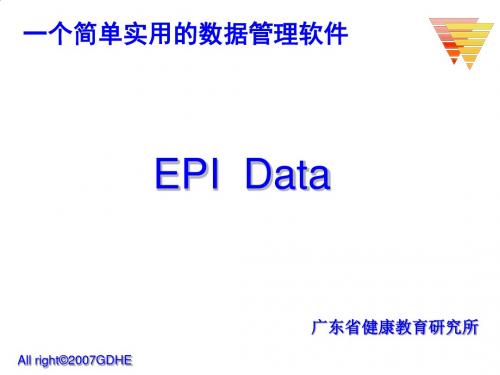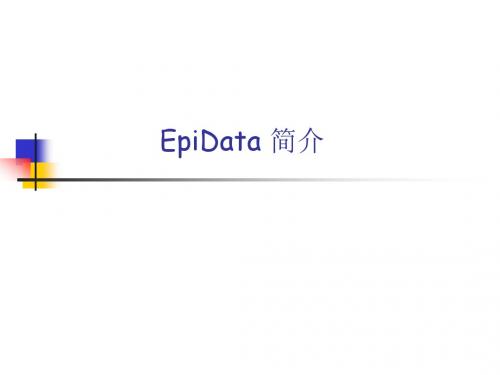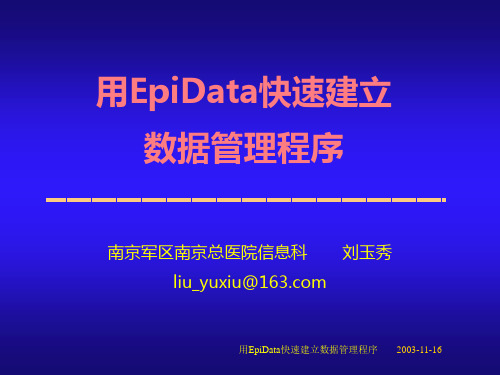epidata教程的ppt
合集下载
【流行病学】epidata课件

建立 调查表文件
创建 数据库
建立 核查文件
输出数据
数据库管理
录入数据
二、建立数据库的流程
• 1、分析或输出记录
1、设计 “问卷”
2.建立(新)调查表文件
方式1: 点击此按钮
方式2: 点击此命令
2.建立(新)调查表文件
方式3: 点击此命令 打开已有的Epidata文件同样有这三种方式
数据管理与统计分析软件 ------ EpiData
•可用的数据录入软件有 :
•Microsoft Access •Microsoft Excel •Foxpro •SPSS •SAS •EpiData
一、主要内容
• 1、什么是EipData • 2、 EipData的开发与特点 • 3、如何安装/运行EipData
EpiData Entry 用于数据录入与数据管理
(最新版本为3.1),有汉化版本;
EpiData Analysis 用于基本的统计描述/分析与制图,
(目前版本为 1.1 )尚无汉化版本。 : epidata.dk/download.php
EpiData 组成
• EpiData Entry由3 种基本文件组成:
• 调查表文件(.QES文件)
•
它的作用是定义调查表(问卷)的结构,
•
即录入界面格式。
• 数据文件(.REC文件)
•
所有录入的数据就存在这个文件之中。
• 数据录入核查文件(.CHK文件)
•
定义字段输入数据的有效性(质量)。
EpiData主界面简介菜单栏
按钮栏
工具栏
工作区 状态栏
EpiData数据管理和输入流程
Epidata语言设置
EpiData使用介绍PPT课件

最长允许80个字符 英文输入状态下,同时按 Shift 键和-键
1. 建立调查表文件
(4)定义变量类型-日期型变量
通常10个字符 <yyyy/mm/dd> 2009年9月10日
<年/月/日 > 日期的录入2009/09/10
20090910 090910 0910 10
1. 建立调查表文件
(5)创建数据库前预览
4. 录入数据
4. 录入数据
(1)记录间转换
移到第一条记录
移到前一条记录(或Ctrl+PgUp,或F7) 移到下一条记录(或Ctrl+PgDn,或F8) 移到最后一条记录
开始录入新记录(或Ctrl+N) 删除记录或恢复一条删除的记录(或Shift+Delete),需 要说明的是,记录只是被标记为删除,实际上,这条记录仍 然存在于数据库中,是可恢复的。在菜单Tools 中选择命令 可以永远的删除所有标记为删除的记录。
5. 数据库管理
数据库的追加/合并
新库中包括A库和B库中的所有变量
5. 数据库管理
数据库的追加/合并
两个数据库都 有的变量
必须是唯一、 不重复的
5. 数据库管理
数据库的追加/合并
只合并标识变量在两个数据库中完全匹配的记录
5. 数据库管理
数据库的追加/合并
合并两个数据库中的所有记录
3. 2. 1.
1. 建立调查表文件
(5)创建数据库前预览
2. 创建数据库
2. 1.
2. 创建数据库
QES和REC可同名、可不同名 可同路径、可不同路径
建议:同名、同路径
2. 创建数据库
可输、可不输 建议:不输
1. 建立调查表文件
(4)定义变量类型-日期型变量
通常10个字符 <yyyy/mm/dd> 2009年9月10日
<年/月/日 > 日期的录入2009/09/10
20090910 090910 0910 10
1. 建立调查表文件
(5)创建数据库前预览
4. 录入数据
4. 录入数据
(1)记录间转换
移到第一条记录
移到前一条记录(或Ctrl+PgUp,或F7) 移到下一条记录(或Ctrl+PgDn,或F8) 移到最后一条记录
开始录入新记录(或Ctrl+N) 删除记录或恢复一条删除的记录(或Shift+Delete),需 要说明的是,记录只是被标记为删除,实际上,这条记录仍 然存在于数据库中,是可恢复的。在菜单Tools 中选择命令 可以永远的删除所有标记为删除的记录。
5. 数据库管理
数据库的追加/合并
新库中包括A库和B库中的所有变量
5. 数据库管理
数据库的追加/合并
两个数据库都 有的变量
必须是唯一、 不重复的
5. 数据库管理
数据库的追加/合并
只合并标识变量在两个数据库中完全匹配的记录
5. 数据库管理
数据库的追加/合并
合并两个数据库中的所有记录
3. 2. 1.
1. 建立调查表文件
(5)创建数据库前预览
2. 创建数据库
2. 1.
2. 创建数据库
QES和REC可同名、可不同名 可同路径、可不同路径
建议:同名、同路径
2. 创建数据库
可输、可不输 建议:不输
医学研究数据管理与统计分析(1)-Epidata-幻灯片

54
编写调查表文件注意事项(二)
④尽可能把字段定义数值型,有利于统计分析。如糖尿病史 “dmhis”可定义为数值型字段,“1”表示“有”,“0”表示“无”。 ⑤调查表文件格式尽可能和原调查表一致,有利于直观录入数据。 ⑥如果用其他文本编辑器编写.qes文件,在运行EpiData后,打开 该.qes文件即可编辑。 ⑦调查表文件的编写是否符合要求,可通过“数据表预览”来查看。
53
编写调查表文件注意事项(一)
①编写过程中及时保存文件,文件类型为.qes文件。 ②系统只会根据“特殊符号”来定义一个输入字段(包括类型和 长度),并根据符号前的字符给字段命名。建议在编写过程中利 用“字段快速清单”插入“特殊符号”,即:选择字段类型,定 义好长度后,按“插入”图标,可避免由于“特殊符号”输入错 误而不能产生有效的输入字段。 ③调查表用中文编写时,可用定界符(“{}”)将字段名定义为英 文字符(英文字母或英文字母+阿拉伯数字),有利于数据库的 管理和其他软件的统计分析。注意:“{}”必须为半角型,而不能 是全角型(“{}”)。
✓ 把握度(power) 1-β,一般0.8-0.9 ✓ 单侧检验还是双侧检验,单侧检验所需样本量小,双
侧检验所需样本量大。
8
常用样本含量的估计软件:EpiCalc 2000
9
常用软件:EPI INFO
10
常用软件:OPENEPI
11
六、原始资料的收集
☉原始资料的收集方式
①直接观察法 ②采访法 包括面访、调查会及信访、电话访 问等 ③…
14
数据录入和管理软件
Dbase, FoxBase,
Visual FoxPro,
15
Lotus
用EPIDATA构建调查表数据库
编写调查表文件注意事项(二)
④尽可能把字段定义数值型,有利于统计分析。如糖尿病史 “dmhis”可定义为数值型字段,“1”表示“有”,“0”表示“无”。 ⑤调查表文件格式尽可能和原调查表一致,有利于直观录入数据。 ⑥如果用其他文本编辑器编写.qes文件,在运行EpiData后,打开 该.qes文件即可编辑。 ⑦调查表文件的编写是否符合要求,可通过“数据表预览”来查看。
53
编写调查表文件注意事项(一)
①编写过程中及时保存文件,文件类型为.qes文件。 ②系统只会根据“特殊符号”来定义一个输入字段(包括类型和 长度),并根据符号前的字符给字段命名。建议在编写过程中利 用“字段快速清单”插入“特殊符号”,即:选择字段类型,定 义好长度后,按“插入”图标,可避免由于“特殊符号”输入错 误而不能产生有效的输入字段。 ③调查表用中文编写时,可用定界符(“{}”)将字段名定义为英 文字符(英文字母或英文字母+阿拉伯数字),有利于数据库的 管理和其他软件的统计分析。注意:“{}”必须为半角型,而不能 是全角型(“{}”)。
✓ 把握度(power) 1-β,一般0.8-0.9 ✓ 单侧检验还是双侧检验,单侧检验所需样本量小,双
侧检验所需样本量大。
8
常用样本含量的估计软件:EpiCalc 2000
9
常用软件:EPI INFO
10
常用软件:OPENEPI
11
六、原始资料的收集
☉原始资料的收集方式
①直接观察法 ②采访法 包括面访、调查会及信访、电话访 问等 ③…
14
数据录入和管理软件
Dbase, FoxBase,
Visual FoxPro,
15
Lotus
用EPIDATA构建调查表数据库
简单实用的数据管理软件--EPI Data分析PPT课件( 36页)

• 择“选项”面板上,分别选择“编辑窗口”、“显示数据 表”和“有关资料”三个选项卡,再将字体设置为中文字 体,这时建议用户将这三个窗口中的字体设置为一致。
补充2:定义变量名
格式:变量标{变量名}变量编码 方法:①直接输入:如右图
②菜单栏更改变量名: “工具”—“更改变量名”—选择所 要更改变量名的.rec文件。
• 如果录入的两位数的年份在50到99之间的话,则被默认为20世纪,前 面加“19”。如果年份值在00和49之间的话则被默认为21世纪,前面 加“20”。如果只录入0405的话,则计算机系统年份自动加入到字段 中。
• 在录入完成后计算机会对录入的日期进行核对,以保证录入的日期值 是合法的日期值。在EpiData中只认四位数年份。
Value Labels (数值标签)
2、编辑已有的标签 在Value label 的下拉列表中选择你要编辑的数值标签 的名字,然后点击右侧的钮,编辑窗口弹出。修改后按菜 单上的“接受并关闭”按钮或者Alt+A 键,保存并关闭编 辑窗口。
3、给变量指定已有的标签 在对应的变量上,从Value label 旁的下拉列表中选择相 关的标签。不同的变量可以共用相同的数值标签,你只需 要定义一次。
CHECK 的文件名必须与数据库(rec文件)的文件名相同, 唯一不同的就是扩展名。
一般情况下,这两种方法我们都会用到。用第一种方法可以进行 最基本的CHECK 设置,然后用编辑器添加更复杂的CHECK 命令 或文件水平(而不是变量水平)上的CHECK 命令。
常用的几个组合键
• Alt+S:相当于按CHECK设置窗口中的“存盘”按钮,保存 所有的CHECK设置。同时,程序不会退出Add/Revise checks;
补充2:定义变量名
格式:变量标{变量名}变量编码 方法:①直接输入:如右图
②菜单栏更改变量名: “工具”—“更改变量名”—选择所 要更改变量名的.rec文件。
• 如果录入的两位数的年份在50到99之间的话,则被默认为20世纪,前 面加“19”。如果年份值在00和49之间的话则被默认为21世纪,前面 加“20”。如果只录入0405的话,则计算机系统年份自动加入到字段 中。
• 在录入完成后计算机会对录入的日期进行核对,以保证录入的日期值 是合法的日期值。在EpiData中只认四位数年份。
Value Labels (数值标签)
2、编辑已有的标签 在Value label 的下拉列表中选择你要编辑的数值标签 的名字,然后点击右侧的钮,编辑窗口弹出。修改后按菜 单上的“接受并关闭”按钮或者Alt+A 键,保存并关闭编 辑窗口。
3、给变量指定已有的标签 在对应的变量上,从Value label 旁的下拉列表中选择相 关的标签。不同的变量可以共用相同的数值标签,你只需 要定义一次。
CHECK 的文件名必须与数据库(rec文件)的文件名相同, 唯一不同的就是扩展名。
一般情况下,这两种方法我们都会用到。用第一种方法可以进行 最基本的CHECK 设置,然后用编辑器添加更复杂的CHECK 命令 或文件水平(而不是变量水平)上的CHECK 命令。
常用的几个组合键
• Alt+S:相当于按CHECK设置窗口中的“存盘”按钮,保存 所有的CHECK设置。同时,程序不会退出Add/Revise checks;
epidata使用方法解析.ppt

精品
2.1建立数据库结构文件(Create Questionnaire File)
表 1 工资调查表 A1 编号 A2 姓名 A3 性别(1)男 (2)女 A4 出生日期年 月 日 B1 基本工资 B2 奖金
精品
2.1.1定义变量名
建立调查表文件是建立数据库、实现数据 录入和管理的第一步。
调查表结构文件在编辑器窗口建立
精品
4大写型字符字段(Upper-case Text)
大写字母的字符型变量<A><A>中可以录 入任意字符,但程序会自动将录入的字母 转换为大写。变量的长度即“<”和“>”间 的字符数,其中包括大写字母“A”所占的1 个字符。上面例子中,第一个变量的长度 为1,第二个变量的长度为5。
精品
5逻辑(布尔)型字段(Boolean Fields,Yes/No Fields)
(File→Options→Create data file)选项卡。 (1)QES文件字体设置:变量名称的字体及其大
小可以在QES文件显示(Show data form)中设置. 。
精品
(2)REC文件字体设置:更改REC文件变量名称 的字体及其大小。
(3)首字符为汉字变量命名方法:系统不支持中 文作为变量名,在如何生成字段名(How to generate field names)标签中选择定义变量名的方 法。在选择“将第一个单词作为变量名”时,如 第一列为汉字(如去除调查表中的A1,A2,A3等变 量名),则系统自动生成变量名如Field1,field2和 field3,同时REC表中中文文字也不再显示。因此, 建议事先以字母形式定义变量名。
结构,然后根据该数据库结构文件生成数据文件 (.rec)。
2.1建立数据库结构文件(Create Questionnaire File)
表 1 工资调查表 A1 编号 A2 姓名 A3 性别(1)男 (2)女 A4 出生日期年 月 日 B1 基本工资 B2 奖金
精品
2.1.1定义变量名
建立调查表文件是建立数据库、实现数据 录入和管理的第一步。
调查表结构文件在编辑器窗口建立
精品
4大写型字符字段(Upper-case Text)
大写字母的字符型变量<A><A>中可以录 入任意字符,但程序会自动将录入的字母 转换为大写。变量的长度即“<”和“>”间 的字符数,其中包括大写字母“A”所占的1 个字符。上面例子中,第一个变量的长度 为1,第二个变量的长度为5。
精品
5逻辑(布尔)型字段(Boolean Fields,Yes/No Fields)
(File→Options→Create data file)选项卡。 (1)QES文件字体设置:变量名称的字体及其大
小可以在QES文件显示(Show data form)中设置. 。
精品
(2)REC文件字体设置:更改REC文件变量名称 的字体及其大小。
(3)首字符为汉字变量命名方法:系统不支持中 文作为变量名,在如何生成字段名(How to generate field names)标签中选择定义变量名的方 法。在选择“将第一个单词作为变量名”时,如 第一列为汉字(如去除调查表中的A1,A2,A3等变 量名),则系统自动生成变量名如Field1,field2和 field3,同时REC表中中文文字也不再显示。因此, 建议事先以字母形式定义变量名。
结构,然后根据该数据库结构文件生成数据文件 (.rec)。
Epidata数据库使用方法详细介绍课件

操作步骤-2
使用制表符@,只会改变变量录入框在表格中的位置, 而不会对变量或REC数据库产生其它不良影响。
在变量编码前插入@,可以将这个变量对齐到下一个 制表位置。
注意:
插入的@与变量编码间不能有空格 文件 →选择项→Show data form→Tabs/Indents→Tab
注意事项
数值型变量:####,最长允许14个字符 字符型变量:_____,最长允许80个字符,一个中文
字占2个字符 日期型变量:<mm/dd/yyyy>
<dd/mm/yyyy> <yyyy/mm/dd>
注意其他变量:自动生成ID号<IDNUM> 逻辑是否<Y>
注意事项
数值型变量允许录入数字、减号和小数点。 在QES 文件中和数据录入过程中, 你可以用圆点
EpiData数据库使用方法简介 及其在健康教育工作中的应用
质选
择
量
合 适
的
的数
据
重
管 理
软
要件
是
方
保 证
数基本情况简介 EpiData使用流程
建立调查表及数据文件生成 添加字段控制 录入数据和数据转出
一、简介(Introduction)
EpiData 是一个免费的 数据录入和数据管理软 件。
.chk文件的建立和常用语法
常用语法
Range:允许范围,允许值
例:4-5,1,2, -inf-5(<=5),0-inf(>=0)
Jump:跳转功能
例:age变量1>v23, 2>v40,3>end,4>write
EpiData-简介 PPT课件

建立核查文件
在创建完数据库(*.rec)后,创建CHECK 文件。
1. 点击菜单中的数据检查→添加或删除检查(最基本) 2. 工作流程栏上点击3. 建立chk文件。 3. 使用编辑器手动编写或修改所有CHECK 命令。
(复杂) 注意:CHECK 的文件名必须与数据库的文件名相同, 唯一不同的就是扩展名(*.chk, *.rec)
简单的实例
建立关于学生体重与身高的调查表 编号 姓名 出生日期 身高 体重 调查日期
建立调查表文件
点击菜单中的文件→新建调查表文件; 在工作流程栏上点击“1. 建立调查表”; 点击编辑器工作栏(常用工具条)上 的 。 窗口中会自动显示一个空白的文档,键入 你的调查表,实际上也就是数据录入表格 的框架。编辑完成后,将此调查表文件保 存,文件的扩展名统一为.QES
定义变量名
如果编码前无任何解释性文字,则延续上一 个变量名,同时在末尾加数字 例如:myfield ,下一个变量名:myfield1 v31, 下一个变量名: v32 如果可生成变量名的第一个单词是一个数字, 程序会自动在数字前插入字母N 例如:”3 little mice” 变量名:N3littlemi
变量类型设置
编辑→字段编辑器 Ctrl+Q 工具栏
定义变量名
一个数据库中录入变量的名称可以根据QES 文 件的内容自动创建。 (1)将第一个单词作为变量名 (2)根据Epi Info 的规则自动定义变量名
设置: “文件”→ “选项”
定义变量名
(1)将第一个单词作为变量名 程序会自动将变量编码左侧解释性文字中的第一个单 词作为变量名(前10个字符)。 例如: V1 Enter age of patient ### 注意:姓名 ___ 姓名name or title ___ 姓名 name or title 结论:软件是以注释语句中,第一个空格前的字符串 为第一个单词,如字符串中有英文,将其作为 变量名,如全是中文,用field1来命名变量 名。
epidata课件

*.REC
check
*.CHK
4、录入数据
*.QES
*.REC
*.CHK
EpiData 要求
EpiData记录数最好不要超过200,000~300,000。 设计录入界面时整个录入界面不能超过999行。 对数值或字符串编码进行解释的文字长度最多80 个 字符 编码长度最多为30 个字符。
EpiData 软件简介
EpiData 特点
简单易学、实用性强 对计算机硬件要求不高 调查表设计便捷
与调查表形式一致的可视数据录入界面
数据核查功能强大且实现简便
数据转换功能强大
EpiData 组成
Epidata软件分为两个模块 EpiData Entry用于数据录入与数据管理(最 新版本为3.1 Build: ( 12Jan2006 ),有汉化 版本; EpiData Analysis(目前版本为 1.1 Rel. 1 (Build 62 ) )用于基本的统计描述/分析与 制图,目前尚无汉化版本。 http://www.epidata.dk/download.php
数据库的追加(Append)
数据库的追加(Append)
n追加的方式有两种:(1)在A
的末记录后追加两者公用字段 的记录,即有相同的变量。数 据库B中的数据,只有与数据 库A相同的变量才会被追加到 新的数据库中,数据库A中没 有的变量会被忽略。(2)在A的 末记录后追加B中所有的字段 和记录
数据库的合并(Merge)
EpiData 组成
EpiData
Entry由3 种基本文件组成:
调查表文件(.QES文件),它的作用是定义调查 表(问卷)的结构,即录入界面格式。 数据文件(.REC文件),所有录入的数据就存在 这个文件之中。 数据录入核查文件(.CHK文件),定义字段输入 数据的有效性。
EpiDate PPT

EpiData的三种文件类型
• QES文件(调查表文件):定义调查表( 问 卷)的结构 (数据库的结构和基础) • REC文件(数据文件):录入界面以及数据存 储;
• CHK文件(核查文件):保证录入过程中的质 量。
• 二 EpiDate的使用流程
1、建立调查表 -----( QES文件)
• QES文件字段的定义
3.添加字段检查和跳转• 源自项基本功: 限定特定值(数值范围,合法值) 指定输入的顺序(跳转) 某些字段不得缺项,必须输入 重复上一条记录的某字段值 标签:给出各数字对应的描述性文本
4.录入数据
• • • • • • 点击“数据录入”,给定数据文件, 即显示数据录入界面 注意事项 无键入内容,仅按回车,以缺失值论 字段填满,光标自动跳到下一个字段 任何时候要退出录入,按F10键即可
XLS文件
SAS文件
SPSS文件
• 推荐
• /html/201004/1593965.html
• 对于每个变量需给出三种信息:
– 变量名
– 变量标签 – 字段格式
如:age
如:年龄 如:##代表两位整数
变量名
• • • • • •
对字段内容的描述或说 明 变量标签
{A1}.编号 ######## 字段格式 {A2}.姓名 ________ 尽量数据化 {A3}.性别 # (1=男 2=女) {A4}.年龄 ##(岁) {A5}.身高 ###.##cm {date}调查日期: <yyyy/mm/dd>
• EpiDate使用简介
----13硕王宁宁
保选 证择 数合 据适 的 质 数 量 据 的 管 重理 要软 方件 面是
为什么选择EpiDate
用EpiData快速建立数据管理程序 PPT课件

可编辑
2020/3/30
EpiData的三种文件类型
QES文件(调查表文件):定义调查表 (问卷)的结构 ; REC文件(数据文件):存放数据以及 已经定义好的编码; CHK文件(核查文件):定义了数据输 入时字段的有效性规则。
可编辑
2020/3/30
用EpiData快速建立数据管理程序 2003-11-16
功能,适于单表,也适于含子表的情形
可编辑
2020/3/30
EpiData基本情况
EpiData秉承EpiInfo DOS版本的简
便性,EpiInfo在世界上已拥有众多用户
简便性体现:以文本形式编写文件,
通过程序将此文本文件转换成数据输入
表格
安装时不受计算机设置的影响。无需
安装或替换任何的DLL文件或系统文件
用EpiData快速建立数据管理程序 2003-11-16
用EpiData快速建立数据管理程序 2003-11-16
EpiData使用流程图
进入
可编辑
2020/3/30
用EpiData快速建立数据管理程序 2003-11-16
建立调查表
建立数据定义是一基础性工作,也 是关键性的工作 在EpiData表现为建成QES文件
可编辑
2020/3/30
QES文件字段定义
• 字符型:用下划线 • 数字型:用#号,每位一#,##.# • 逻辑型:用Y或N,<Y>、<N> • 日期型:<mm/dd/yyyy>
<dd/mm/yyyy> • 字段名框在{ }之中
可编辑
2020/3/30
QES文件字段定义—举例
id
(automatic id number)
用EpiData快速建立数据管理程序课件

数据校验规则
用户可以根据需要自定义 数据校验规则,对数据进 行有效性检验,确保数据
的准确性。
核查与校验流程
在数据录入过程中,可以 通过设置核查与校验流程,
对数据进行实时监控,及 时发现并纠正错误。
数据导出与导入
01
02
03
数据导出格式
EpiData支持多种数据导 出格式,如Excel、CSV、 SPSS等,方便用户进行数 据分析和共享。
数据导入功能
EpiData还具备数据导入 功能,用户可以从外部数 据源导入数据,实现数据 的整合和共享。
数据转换工具
EpiData提供数据转换工 具,方便用户对数据进行 清洗、整理和转换,提高 数据质量。
自定义数据管理程序
自定义查询
自定义数据管理流程
用户可以根据需要自定义查询语句, 对数据进行筛选、排序和分组等操作。
在下拉菜单中选择“新建”,然 后选择“项目”。
03
输入项目名称和保存路径,然后 点击“保存”按钮。
04
在弹出的对话框中,选择所需的 选项,如数据集类型、数据集名 称等,然后点击“确定”按钮。
打开已有项目
9字
9字
打开EpiData软件,点击菜单栏中 的“文件”选项。
1
3
在弹出的对话框中,浏览并选择 要打开的项目文件,然后点击“
根据需要选择合适的导出格式, 如Excel、CSV等。
优化导出设置
在EpiData的导出设置中进行优 化,确保数据的完整性和准确性。
提高计算机性能
对于大量数据的导出,提高计 算机的性能可以加快导出速度。
06
EpiData案例分享
案例一:某地区传染病发病率调查
Epidata的使用.ppt

1.新建qes文件即调查表文件,输入变量名称(字段 名,如:name,age),变量描述文本(变量标签,如: 姓名,年龄),定义字段格式,长度(如,数值型变量 长度5位,小数点后两位###.##);
2.根据调查表文件生成记录文件; 3.添加核对命令,定义变量的合法值,设置跳转等.
2020/4/12
7
2020/4/12
15
字段重命名
如果对于字段的名字不满意可以重新命名 菜单:工具->字段重命名
2020/4/12
16
2020/4/12
17
三、添加核对命令,生成核对文件
注意:当前窗口为qes文件或者rec预览文 件或者录入文件时,不能添加核对命令
首先,关闭调查表文件与rec文件,然后, 点击工作流程栏中的 3、建立CHK文件, 或者,菜单->数据录入质控
spss、Stata等数据格式。
2020/4/12
3
局限性:
变量类型比较局限,变量名长度只有8位, 变量标签最多80位,编码长度最长30位
记录不要超过200,000-300,000 数据文件结构最长999行 不能分页
2020/4/12
4
快捷按钮
菜单栏
工作流 程栏
2020/4/12
5
Epidata的录入文件
Epidata 数据录入软件的使用
姜世强
Epidata简介
Epidata是一个免费的数据录入&数据管 理软件。开发者是丹麦欧登塞的一个非盈 利组织。
主要用于数据录入。
www.epidata.dk
2020/4/12
2
特点:
免费软件,小巧,只有一兆多。 设计比较简单,易学易用。 支持多种格式,可以导出Excel、SAS、
2.根据调查表文件生成记录文件; 3.添加核对命令,定义变量的合法值,设置跳转等.
2020/4/12
7
2020/4/12
15
字段重命名
如果对于字段的名字不满意可以重新命名 菜单:工具->字段重命名
2020/4/12
16
2020/4/12
17
三、添加核对命令,生成核对文件
注意:当前窗口为qes文件或者rec预览文 件或者录入文件时,不能添加核对命令
首先,关闭调查表文件与rec文件,然后, 点击工作流程栏中的 3、建立CHK文件, 或者,菜单->数据录入质控
spss、Stata等数据格式。
2020/4/12
3
局限性:
变量类型比较局限,变量名长度只有8位, 变量标签最多80位,编码长度最长30位
记录不要超过200,000-300,000 数据文件结构最长999行 不能分页
2020/4/12
4
快捷按钮
菜单栏
工作流 程栏
2020/4/12
5
Epidata的录入文件
Epidata 数据录入软件的使用
姜世强
Epidata简介
Epidata是一个免费的数据录入&数据管 理软件。开发者是丹麦欧登塞的一个非盈 利组织。
主要用于数据录入。
www.epidata.dk
2020/4/12
2
特点:
免费软件,小巧,只有一兆多。 设计比较简单,易学易用。 支持多种格式,可以导出Excel、SAS、
用EpiData快速建立数据管理程序课件

总结词
强大的数据校验功能
总结词
灵活的数据导入导出功能
详细描述
EpiData支持多种数据导入导出格式,如Excel、CSV、 SPSS等,方便用户在不同软件之间进行数据交换和共享 。这为用户提供了更大的灵活性,可以根据需要选择合适 的数据处理软件。
案例二
总结词
适用于多种流行病学调查
详细描述
流行病学调查是公共卫生领域中非常重要的一项工作,而 EpiData正是为此类调查设计的软件。通过EpiData,调 查人员可以快速地设计调查问卷、收集数据、进行数据校 验和整理,大大提高了流行病学调查的效率和准确性。
数据导出功能介绍
数据导出
EpiData支持多种导出格式,如 Excel、CSV等,方便用户将数据 用于其他软件或平台进行分析。
导出设置
用户可以根据需要自定义导出字 段和格式,确保导出的数据符合
自己的需求。
导出速度
EpiData优化了导出性能,能够 快速导出大量数据,提高了工作
效率。
数据整理功能介绍
数据格式不统一
在录入数据前,应统一规定数据的格式和标准,如日期格式、数字 的千分位分隔等,以确保数据的一致性。
数据丢失或重复
为避免数据丢失或重复,建议在录入过程中采用校验功能,如数据 唯一性校验、范围校验等,确保数据的准确性和完整性。
数据核查常见问题与解决方案
数据核查繁琐
EpiData提供了多种核查功能,如简单核查、复杂核查和自定义核 查等,可根据实际情况选择合适的核查方式,简化核查流程。
核查规则定制
用户可以根据需要定制核 查规则,提高数据质量。
数据导出与整理
导出格式
数据转换
EpiData支持多种导出格式,如Excel 、CSV等,方便用户进行数据整理和 分析。
强大的数据校验功能
总结词
灵活的数据导入导出功能
详细描述
EpiData支持多种数据导入导出格式,如Excel、CSV、 SPSS等,方便用户在不同软件之间进行数据交换和共享 。这为用户提供了更大的灵活性,可以根据需要选择合适 的数据处理软件。
案例二
总结词
适用于多种流行病学调查
详细描述
流行病学调查是公共卫生领域中非常重要的一项工作,而 EpiData正是为此类调查设计的软件。通过EpiData,调 查人员可以快速地设计调查问卷、收集数据、进行数据校 验和整理,大大提高了流行病学调查的效率和准确性。
数据导出功能介绍
数据导出
EpiData支持多种导出格式,如 Excel、CSV等,方便用户将数据 用于其他软件或平台进行分析。
导出设置
用户可以根据需要自定义导出字 段和格式,确保导出的数据符合
自己的需求。
导出速度
EpiData优化了导出性能,能够 快速导出大量数据,提高了工作
效率。
数据整理功能介绍
数据格式不统一
在录入数据前,应统一规定数据的格式和标准,如日期格式、数字 的千分位分隔等,以确保数据的一致性。
数据丢失或重复
为避免数据丢失或重复,建议在录入过程中采用校验功能,如数据 唯一性校验、范围校验等,确保数据的准确性和完整性。
数据核查常见问题与解决方案
数据核查繁琐
EpiData提供了多种核查功能,如简单核查、复杂核查和自定义核 查等,可根据实际情况选择合适的核查方式,简化核查流程。
核查规则定制
用户可以根据需要定制核 查规则,提高数据质量。
数据导出与整理
导出格式
数据转换
EpiData支持多种导出格式,如Excel 、CSV等,方便用户进行数据整理和 分析。
- 1、下载文档前请自行甄别文档内容的完整性,平台不提供额外的编辑、内容补充、找答案等附加服务。
- 2、"仅部分预览"的文档,不可在线预览部分如存在完整性等问题,可反馈申请退款(可完整预览的文档不适用该条件!)。
- 3、如文档侵犯您的权益,请联系客服反馈,我们会尽快为您处理(人工客服工作时间:9:00-18:30)。
Automatic field names, examples
Question:
Did you {eat ice cream} What is your name? 2. Age
Field name:
EATICECREAM ISYOURNAME N2AGE
Variable type
• Define variables using “Pick List” or “Code writer” • Choose type of variable:
Field name (variable)
• No more than 10 characters • Begin with a letter • No spaces or punctuation marks
Field Name (II)
• First word
– Uses first word of line
– (click Make data file > preview data form)
Structure of questionnaire
Three sections:
– Field name (variable) – Text describing field – Input definition (number/ letters/ date)
– <Today-dmy> – <Today-mdy>
• Auto identification number: Counts the records entered
– <IDNUM>
Save Questionnaire
• Preview data • Save questionnaire – Creates .QES file • Create Data file – Click Make Data file button > Make Data file – Creates .REC file • Questionnaire and Data file ready • But……
Errors in data entry
• Tranposition (ex: 39 becomes 93)
• Copying errors (0 copy as an “o” letter) • Consistency errors: two or more responses
are contradictory (sex: man, pregnancy=Yes)
• Automatic
– EpiData generates field names based on question – Uses first 10 letters
Childquest Child questionnaire <Y>
Automatic field names
• Text in curly brackets { } used in preference • Common words skipped (what, the, and, etc.) • If question starts with number, “N” is inserted before the number
Data Entry (I)
• Click Enter data button > choose .REC file • Dates:
– 15/5/2006 – type 150506 or 15/5/06
• Value Labels:
– Press F9 to view
Data Entry (II)
EpiData (II)
• Simple surveys – one questionnaire • Complicated surveys – few questionaires If there is ID – possible to merge data
EpiData files
• .QES file
– – – – – – Numeric Text Date Soundex Boolean (Yes/No) Autonumber
Text variables
• Information of text and/or numbers • Holding information (e.g. names, addresses) • UPPER CASE
• Record navigation:
• Delete records:
– Click cross to delete – Record marked for deletion, but can be recovered
Document Tools
• File Structure • Data entry notes ( .NOT file)
– Use to write comments during data entry eg: difficult to read handwriting etc
• Range errors: answers outside of probable or
possible values (ex: heigh = 3 metres)
Preventing errors
• Standardised and previously tested questionnaire • Training the interviewers and data entry clerck • Checking and validating paper forms of the questionnaires • Checking during the data entry (Check module EpiData) • Validation: entering twice data by different operators • Checking after data entry (Analysis module Epi-Info)
• Soundex:
– Coding of words (anonymous, eg. A-123) – Code to limit orthographic errors (eg. Rome and Roma) – <S >
System variables
• Values generated automati the data entry
– Can only hold upper case (capital) letters – Lower case variable automatically converted into upper case text (ex: Egypt converted into EGYPT)
• No mathematical operations • Length (How many characters) • <_>
Creating Questionnaire
• Define Data • Can either open .QES file or create one
New questionnaire
• Type in window • Cut and paste from Word documents • Preview questionnaire
Numeric variables
• Numerical information • Hold integers (whole numbers) or numbers with a decimal point • Length (digits, decimals after the comma) • <#>, <##.#>
– Questionnaire
• .REC file
– Actual data
• .CHK file
– Any defined checks
• Other notes or log files
EpiData workflow
1.Define Data 2.Make Data File 3. Set up Checks 4.Enter Data 5.Document 6.Export Data
Checks (II)
• Once Data file is created: • Click Checks button > choose .REC file
Checks (III)
• Range, legal: – 1-3, 9 – First range then individual numbers – Tallinn, Riga, Vilnius – Fixing only min or max value • -INF-5 (all numbers inferior or equal 5)
• 0-INF (all positive numbers superior or equal to 0)
• Jumps:
– – – – Field: AGEYEARS 0>AGEMONTHS 0>AGEMONTHS, 1>ADDRESS 1>END
• MustEnter:
– Data must be entered in Field
Checks (IV)
• Repeat:
– Show data from previous record
• Value Label
– Add text to explain values – Click + to add label – Format as shown – Press F9 during data entry to see labels
